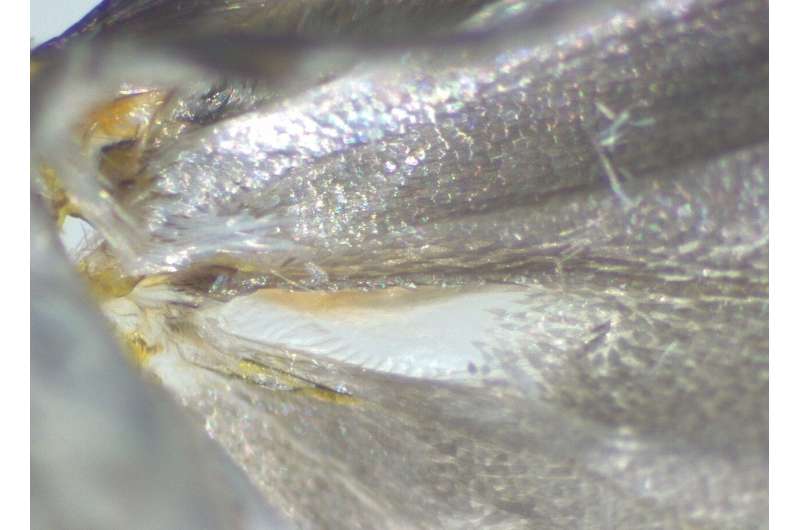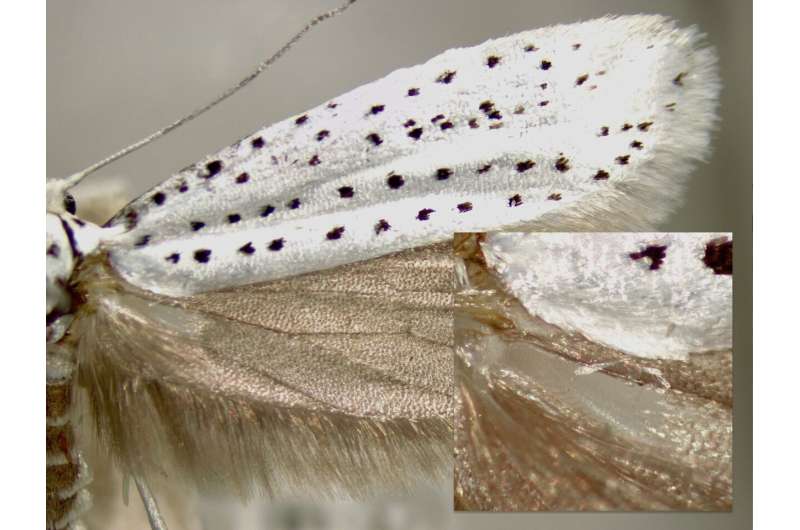This article has been reviewed according to Science X's editorial process and policies. Editors have highlighted the following attributes while ensuring the content's credibility:
fact-checked
peer-reviewed publication
trusted source
proofread
Mystery of moths' warning sound production explained in new study

The workings of the ultrasonic warning sounds produced by the wings of a species of moth have been revealed by researchers at the University of Bristol.
Scientists recently discovered that moths of the genus Yponomeuta (so-called ermine moths) have evolved a very special acoustic defense mechanism against their echolocating predators—bats.
Ermine moths produce ultrasonic clicking sounds twice per wingbeat cycle using a minute corrugated membrane in their hindwing. Strikingly, these moths lack hearing organs and are therefore not aware of their unique defense mechanism, nor do they have the capability to control it using muscular action.
In the study, published in Proceedings of the National Academy of Sciences, an interdisciplinary team of engineers and biologists from Bristol show how individual ridges of a corrugated patch in the hindwings of ermine moths snap-through because of in-flight wing folding. The sudden snap-through of these features vibrates an adjacent membrane, significantly amplifying the strength and direction of the produced sound. Owing to its passive in-flight actuation, this sound-producing organ is known as an "aeroelastic tymbal."
Marc Holderied, Professor of Sensory Biology at the School of Biological Sciences, explained, "Our goal in this research was to understand how the corrugations in these tymbals can buckle and snap through in a choreographed way to produce a chain of broadband clicks. With this study, we unfolded the biomechanics that triggers the buckling sequence and shed light on how the clicking sounds are emitted through tymbal resonance."
The study's first author, Hernaldo Mendoza Nava, who investigated the mechanics of the aeroelastic tymbal as a Ph.D. student at the EPSRC Center for Doctoral Training in Advanced Composites for Innovation and Science of the Bristol Composites Institute (BCI), said, "Sound production and radiation is linked to mechanical vibration, for example in the skin of a drum or a loudspeaker.
"In ermine moths, the snap-through buckling events act like drumbeats at the edge of a tymbal drum, exciting a much larger portion of the wing to vibrate and radiate sound. As a result, these millimeter-sized tymbals can produce ultrasounds at the equivalent level of a lively human conversation."
To uncover the mechanics of the aeroelastic tymbal, Hernando combined state-of-the-art techniques from biology and engineering mechanics. The biological characterization of the wing's morphology and material properties ultimately led to detailed computer simulations of the snap-through response and sound production that match recorded moth signals in frequency, structure, amplitude, and direction.
Rainer Groh, Senior Lecturer in Digital Engineering of Structures at the BCI added, "The integration of various methods across the sciences with a consistent information flow across discipline boundaries in the spirit of 'team science' is what made this study unique and a success. In addition, without the amazing modern capabilities in imaging, data analysis and computation, uncovering the mechanics of this complex biological phenomenon would not have been possible."
The discovery will help researchers understand many other insect species with similar sound production mechanisms, filling a page of anti-bat acoustic defenses in the book on the age-old arms race between echolocating bats and their insect prey.

Structural buckling and sound production are rarely studied together, despite being reciprocal phenomena. In addition, buckling occurs as a sudden large deformation which can be attractive as a shape-changing mechanism in the field of morphing structures, such as in the aerospace industry, where engineers are looking to optimize the aerodynamic performance of wings.
Alberto Pirrera, Professor of Nonlinear Structural Mechanics at the BCI, concludes, "In the realm of engineering design, nonlinear elastic responses, such as buckling and snap-through instabilities, have traditionally been perceived as failure modes to be avoided. In our research, we have been advocating a paradigm shift and have demonstrated that buckling events can be strategically leveraged to imbue structures with smart functionality or enhanced mass-efficiency. Yponomeuta's aeroelastic tymbal embodies the concept of beneficial nonlinearity."
"The natural world, once again, serves as a source of inspiration."
The research team anticipates that through bioinspiration, aeroelastic tymbals will encourage novel developments in the context of morphing structures, acoustic structural monitoring and soft robotics.
More information: Buckling-induced sound production in the aeroelastic tymbals of Yponomeuta, Proceedings of the National Academy of Sciences (2024). DOI: 10.1073/pnas.2313549121. doi.org/10.1073/pnas.2313549121
Journal information: Proceedings of the National Academy of Sciences
Provided by University of Bristol


















